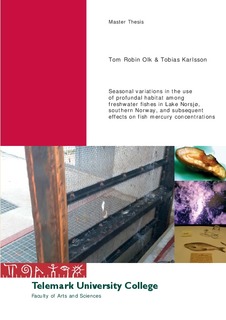| dc.description.abstract | This study is based on monthly sampling of fish from an industrial water intake, located at the bottom of Lake Norsjø, at a depth of 50 m, during one year (2014). By this sampling strategy, we have obtained unique information about the seasonal use of the profundal habitat among > 15 fish species present in the lake. However, besides a very few individuals of perch (Perca fluviatilis, n = 4) and one individual of Nortern pike (Esox lucius) and brown trout (Salmo trutta L.), respectively, only Arctic char (Salvelinus alpinus), European smelt (Osmerus eperlanus) and whitefish (Coregonus lavaretus) were caught. While A. char was present in the profundal habitat all year, E. smelt were only absent in June, and whitefish was primarily present during the winter, December-March. The main reasons for searching to this poor, cold and dark habitat, are primarily predator avoidance, interspecific competition, hatching and subsequent feeding on row. The various use of the profundal habitat among fish species, have primarily been linked to age, length and weight, stomach analyses and stable isotope signatures, δ13C and δ15N, in fish muscle. By also comparing the number of gill rakers (NGR) in whitefish caught by gill nets in a nearby littoral area, we revealed two morphs of whitefish, a profundal morph (NGR = 26.5 ± 0.4) and a littoral morph (NGR = 32.0 ± 0.6). The varying degree of habitat use (profundal, pelagic, littoral) among fish species and morphs, has further been shown to have implication for the mercury (Hg) concentration in fish, as baseline Hg and fish growth differ between different lake habitats. Accordingly, these factors, besides the more classical factors as trophic position and age, are essential for Hg concentration in fish. | |
